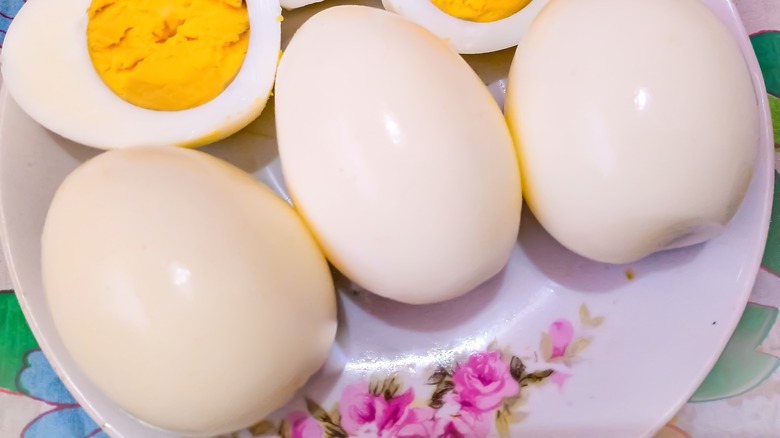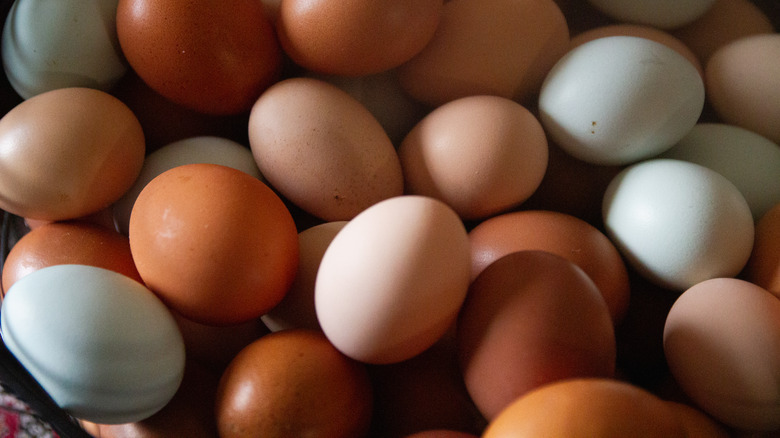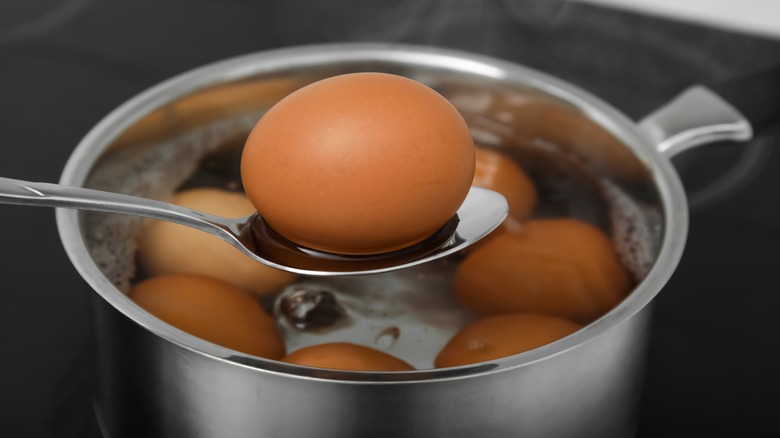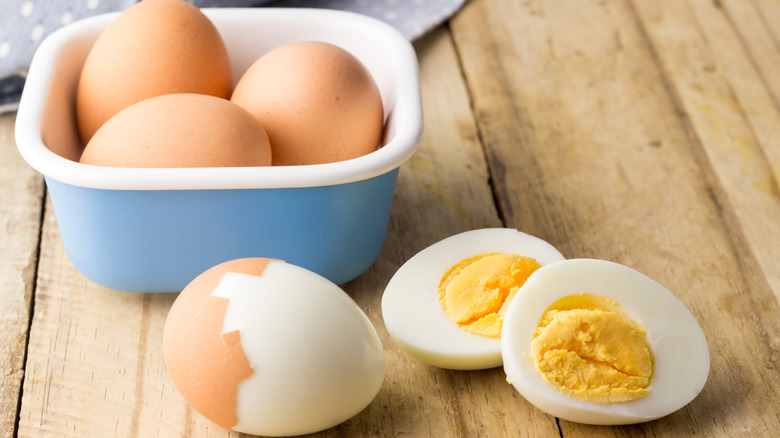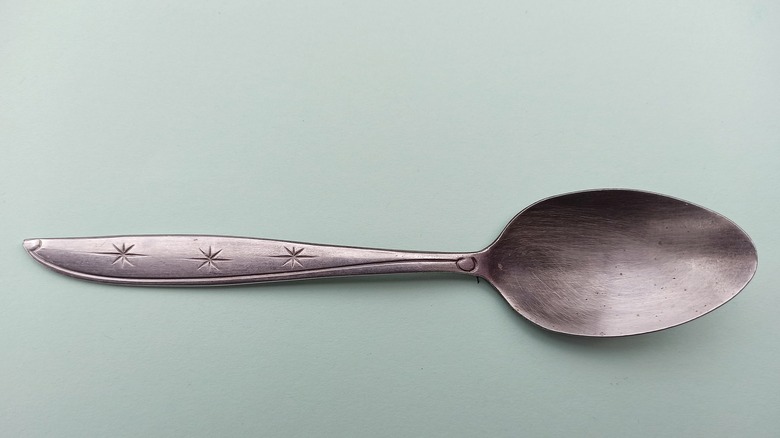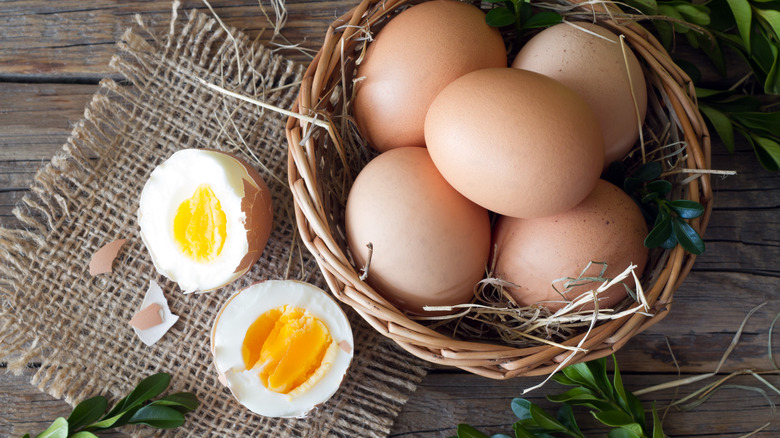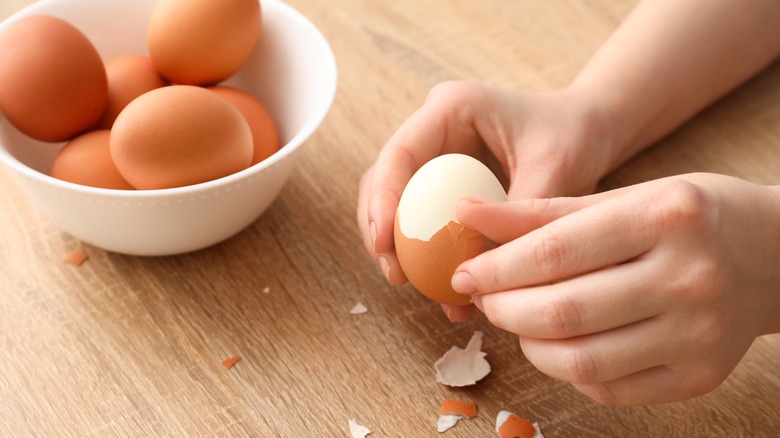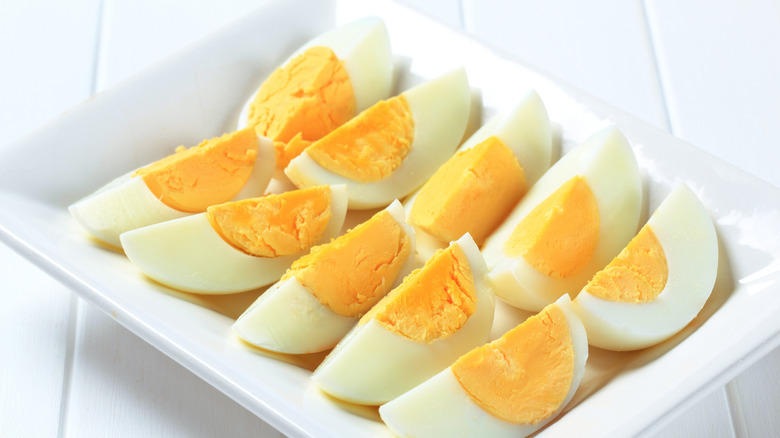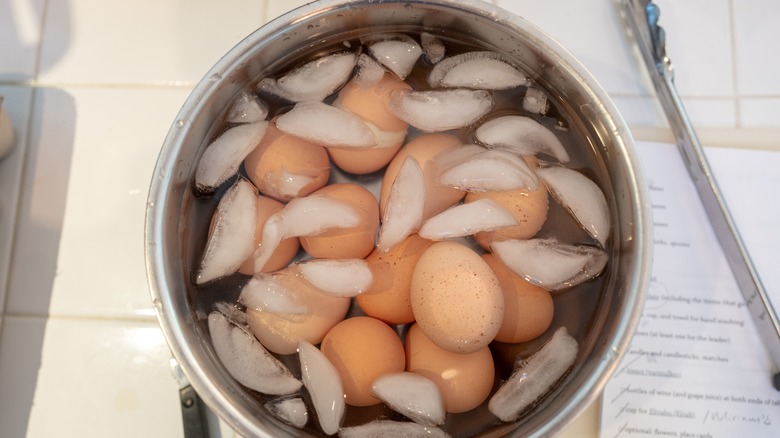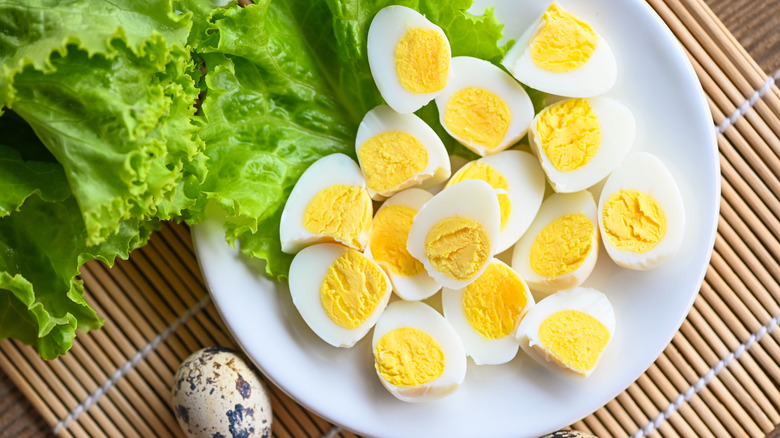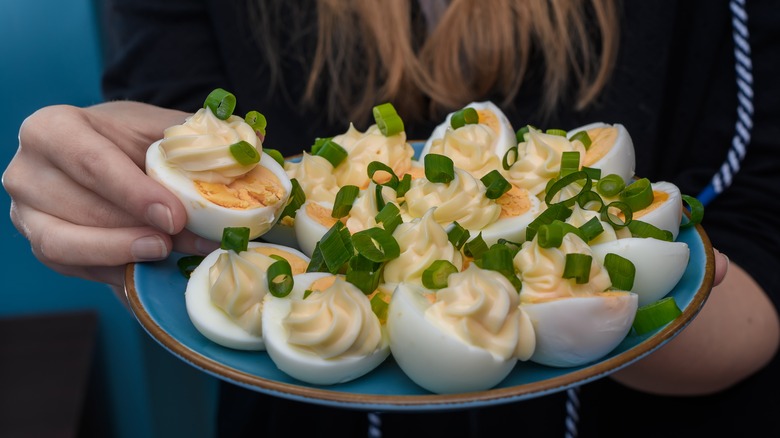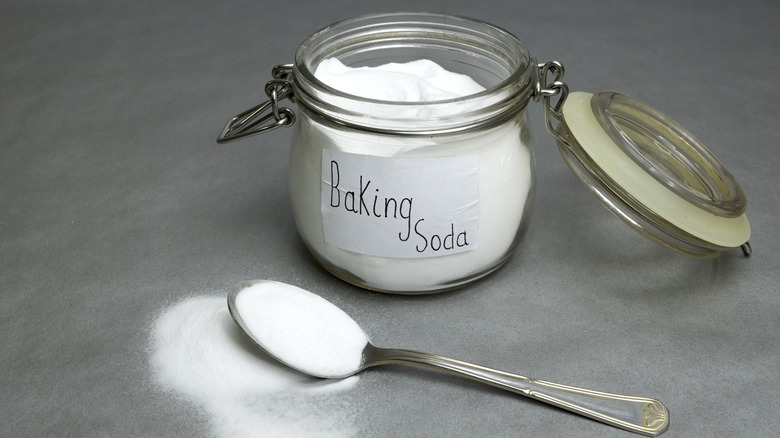11 Mistakes Everyone Makes When Peeling Hard-Boiled Eggs
Hard-boiled eggs are a dependable standby for many busy cooks. Besides being quick and easy to make, they're durable and will last in the fridge for a few days or survive a day-long hike or beach trip. On top of that, hard-boiled eggs are super versatile: You can dress them up as a filling for elegant tea sandwiches, slice them to add color and heft to a simple salad, toss them into your backpack for a handy snack, or make deviled eggs.
Peeling is one of the few vexing things about preparing hard-boiled eggs. It's fussy, slow work if the shell sticks to the egg white. And all too often, rushed attempts to get the shell off result in ugly cracks and divots in the tender whites — and suddenly your eggs look like they've been through a war zone. While this isn't an issue if you're planning to chop your eggs, it can be a real nuisance if you want them to look pretty. So let's put your egg-peeling problems to a stop right now — because we're sharing some common mistakes and how to avoid them. Get cracking!
Using fresh eggs
If you're lucky enough to raise your own chickens — or have a generous friend who does — you appreciate the simple pleasures of a truly fresh egg. But if you've ever hard-boiled fresh eggs, you've probably found them an epic pain to peel. This is because fresh eggs and their membranes are still tightly bound to the shell – as eggs age, their insides shrink and start to pull the membrane and shell apart. As a result, older eggs peel more easily. Fresh eggs, on the other hand, stick to their shells, so peeling is much harder.
If you want to make and peel a bunch of hard-boiled eggs without stress, choose older eggs. Save your super-fresh ones for preparations where their virtues truly shine. Since fresh eggs have perkier yolks and thicker, firmer whites that hold their shape, they make especially attractive (and tasty) poached eggs. For the same reasons, fresh eggs will come out attractively egg-shaped when fried, while older eggs may fry up as shapeless blobs. Save your older eggs for hard-boiling, and you won't be sorry.
Starting to cook eggs in cold water
A lot of myths have popped up about the best ways to cook a hard-boiled egg. Some say you should bring a pot of water to a boil before adding the eggs, which allows the eggs to cook more quickly. But others advocate for putting them into a pot of cold water before bringing them to a boil. This method, they argue, reduces the risk of cracked shells and creates more tender whites.
This may be true, but the cold-water method has another, less-desirable side effect as well: It makes hard-boiled eggs that are a pain to peel. Because eggs cook more slowly when started in cold water, they form a tighter bond with the membrane lining the eggshell. So while starting your eggs in cold water will give you a better chance of producing boiled eggs with pristine, uncracked shells, these shells will stick to the egg like no one's business. For faster cooking and peeling, start your eggs in boiling water.
Not chilling the eggs before peeling
If you've ever tried to peel a hot-from-the-pot hard-boiled egg, you'll understand why hard-boiled eggs are typically served cold. Even if you can ignore the pain of scalded fingers, you'll find hot eggs difficult and time-consuming to peel. This is because egg whites tend to stick to the membrane lining in the shell during cooking – and only pull away from the membrane as they cool.
Thus, your best bet for quick peeling is to accelerate the cooling process by placing the eggs in ice water after cooking. Allowing them to chill in an ice water bath for about 15 minutes will give the eggs enough time to cool, contract, and pull away from the shell. While you may think these 15 minutes may be more productively used for actual egg-peeling, trust the process: Once you experience how much faster it is to peel cold eggs than hot ones — and how easily you can enjoy flawlessly peeled eggs with nick-free whites — you'll be glad you waited.
Using a spoon
Among the many tips for peeling hard-boiled eggs is the hack of slipping a spoon between the cooked egg and shell to separate them. The curved shape of the spoon — at least in theory — should smoothly follow the contours of the egg and help you gently pry the shell off.
This would work beautifully if spoons and eggs all had the same curvature. Unfortunately, this isn't the case. In reality, trying to slip a spoon between the shell and the egg, or trying to rotate it around the egg to loosen the shell, can result in the spoon digging an unattractive gash into the egg's surface. In addition, you still need to peel off a significant bit of the shell by hand so you'll have an opening for the spoon. Yes, you can make the spoon hack work, if you take your time and get lucky with your choice of spoons and eggs. But you won't be saving yourself any time or work.
That blowing hack
Just when you thought the internet couldn't possibly deliver another viral hack, along came the clever trick of blowing a hard-boiled egg out of its shell. It's easy to see why people find it so fascinating: All you have to do is break off quarter-sized pieces of the shell at both ends of an egg and blow into one of the openings — and the egg should pop right out.
It's a fun trick and cool to watch, and yes, the egg really does come out. The catch is, however, that you may have to blow really, really hard multiple times to get this to happen. This, combined with the fact that you have to prep the egg first by peeling off the ends of the shells, make the whole operation needlessly time-consuming. This method is also questionable from a sanitation perspective: Would you eat deviled eggs prepped by a stranger who'd blown on each of them multiple times?
Forgetting to pre-crack eggs before peeling
For those in a hurry to peel a hard-boiled egg, a common strategy is to crack the shell against a hard surface and start peeling. While this works, it's neither the fastest nor easiest way to get the job done. You might find yourself fighting to unstick bits of the shell from the egg or accidentally digging your fingernails into the tender egg white.
A cleaner and more efficient way to ensure easy peeling is to prep the eggs first by pre-cracking them. And oddly enough, this extra step will actually save you time: Gently tap the egg against the counter as usual, then roll it around in your hands or against the counter, pressing firmly, until the entire shell is cracked. (Be careful, however, not to press so hard that you crack the egg itself.) The pre-cracked shell should take just a few seconds to peel away, leaving you with a clean, undamaged egg.
Not peeling eggs under water
We've all had the experience of peeling a hard-boiled egg, sprinkling on some salt and pepper, and taking a nice big bite — only to crunch down on a chalky shell shard. It's a real turnoff, not to mention a weird feeling and sound on your teeth. But it keeps happening because little bits of shell like to stick to eggs, and if you're cooking white eggs, these little fragments can be easy to miss.
Some cooks rinse peeled eggs under a faucet to remove any stubbornly stuck shell shards, but there's an easy way to avoid these irritating fragments altogether: Peel your eggs in a bowl of water. Fill a good-sized bowl with cold or room-temperature water, crack your hard-boiled egg, immerse it in the water, and peel away. The water slips between the egg and its shell, helping the shell break away more easily. It also rinses off any stray bits of shell that you may have overlooked. This method not only gives you pristine eggs, but spares you the time and water waste of a final faucet rinse.
Peeling large batches of eggs one at a time
If you find peeling a single hard-boiled egg to be tedious, the prospect of peeling a large batch of them may seem formidable. But sometimes, it has to be done. However, if you find yourself in charge of, say, making deviled eggs for several dozen people, don't think you have to peel each egg individually. Instead, take advantage of an easy hack for peeling multiple eggs all at once.
To peel eggs in batches, put about five cooled hard-boiled eggs in a plastic container and add some water. Cover the container and shake it vigorously. As the eggs hit against each other, they'll crack each other's shells, and the water will help separate them from the eggs. When the shells have fallen away, remove the peeled eggs and repeat with the remaining eggs. This method is not only easy and efficient, but you never know ... it might even help relieve a little stress.
Overcooking your eggs
We love hard-boiled eggs for their sturdiness — they not only offer a satisfying, hearty bite, they're durable enough to make great backpacking snacks and sack-lunch staples. But while firm, structurally stable eggs are great, overcooked ones are a bummer — no one likes rubbery eggs with chalky yolks surrounded by hard layer of gray.
And here's yet another reason not to overcook your eggs: It makes them harder to peel. To avoid overcooked hard-boiled eggs, keep a close eye on the cooking time and be aware that room-temperature eggs will cook up faster than eggs taken straight from the refrigerator. For perfectly firm, but not rubbery, hard-boiled eggs, bring a pot of water to a rolling boil, then gently lower cold eggs into the pot. Lower the heat to a gentle boil to keep the eggs from bouncing around and breaking, then set the timer for 10 minutes. When the timer goes off, immediately remove the eggs and shock them in a bowl of cold water to stop further cooking — and make them easier to peel.
Pricking raw eggs with a pin
A classic bit of lore about hard-boiled egg cookery is that one should prick a hole at the wide end of each egg with a pin. This step, according to some theories, will release the air pocket at the end of the egg, resulting in a boiled egg without the typical flat spot near its bottom. It's also supposed to prevent cracking and even make eggs easier to peel. The catch, however, is this is fiddly work and unless you have a steady hand, can cause you to break your eggs instead of cleanly piercing them.
So is this extra step worth the risk? Some tests have found that pinholes make no difference in how easily an egg peels, so if easy peeling is your priority, you can skip this step. In addition, it's not even a sure-fire way to get a perfectly shaped egg – cooking water can enter the pinhole and cause even more oddly shaped pockets to form on the surface of the egg white. If you really want your eggs to have a geometrically perfect egg shape, your best bet is to submerge the eggs in ice water immediately after cooking. This will cause the steam that has built up in the egg's air pocket to condense and give the still-malleable egg room to expand, resulting in a perfectly smooth egg.
Putting baking soda in the cooking water
Baking soda has a reputation as a kitchen miracle worker — it's cheap, accessible, and can do everything from lend airiness and heft to cakes and biscuits to clean grunge-covered pots and eliminate stale food odors from refrigerators and garbage disposals. And many also believe it can make eggs easier to peel — just add baking soda to the cooking water. The alkalinity of the baking soda is thought to raise the pH of the egg white, which helps loosen the bond between the egg white and shell, enabling cooked eggs to peel more easily. This is supposed to be an especially useful hack if you want to hard-boil fresh eggs, which have a lower pH than older ones.
While this sounds great in principle, cooks who've tested eggs boiled with and without baking soda side by side have found that it makes no real difference in how easily the eggs peel. And the only real, noticeable difference the baking soda contributes is a sulfurous odor to the eggs. So when hard-boiling eggs, skip the baking soda and save it for more productive purposes.

